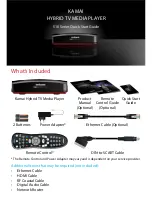
Analog:
Sound that has not been turned into numbers. Analog sound
varies, while digital sound has specific numerical values. Analog sound is
available when you use the red and white audio jacks on your equipment.
These jacks send audio through two channels, the left and right.
AUDIO OUT Jacks:
Jacks on the back of the DVD Player that send
audio to another system (TV, Stereo Receiver, etc.).
Bit Rate:
The amount of data used to hold a given length of music; mea-
sured in kilobits per seconds, or kbps. Or, the speed at which you record.
Generally, the higher the bit rate, or the higher the recording speed, the
better the sound quality. However, higher bit rates use more space on a
disc.
For example, an MP3 music file recorded at 32 kbps will record slowly, use
the least Disc space, and have the poorest sound quality. But, an MP3
music file recorded at 96 kbps will record quicker, use more Disc space,
and have significantly better sound quality.
CD
: Compact Disc (audio).
COAXIAL jack:
Sends digital audio to a Stereo Receiver, allowing you
to adjust the volume at the Receiver. The Receiver must have a coaxial in
jack. This connection provides the 5.1 channel surround sound as heard in
movie theaters.
Component Video Out Jacks
: Pr/Cr Pb/Cb Y Jacks on the back of the
DVD Player that send high-quality video to a TV that has Component
Video In jacks. Use the separate PROGRESSIVE SCAN OUT Pr/Cr Pb/Cb Y
jacks only if your TV has Progressive Scan.
Digital:
Sound that has been converted into numerical values. Digital
sound is available when you use the COAXIAL or OPTICAL Digital Audio
jacks on your equipment. These jacks send audio through multiple chan-
nels, instead of just two channels as analog does.
Dolby Digital:
A surround sound system that provides 5.1 channel sound
as used in movie theaters.
DTS:
Digital Theater Systems. This is a surround sound system, but it is
different from Dolby Digital. The formats were developed by different
companies.
DVD
: Digital Video Disc.
Letterbox:
A TV aspect ratio setting (4:3). Displays the video in full-
width, with black bars at the top and bottom of the TV screen. This format
is similar to seeing a movie in a theater. If the Disc does not include a let-
terbox format , selecting 4:3 Letterbox may have no effect. (For example,
some DVD discs are two-sided, with one side playing in Letterbox and the
other side playing in a normal format.)
OPTICAL Jack:
Converts electrical signals into optical signals before
sending the audio to the Stereo Receiver. Optical audio is not prone to
external electrical influences and has less noise, which reduces adverse
effects on external equipment. Be sure to keep the protective cap on the
jack when the jack is not in use. This keeps dust out of the jack.
Pan & Scan:
A TV aspect ratio setting (4:3). Displays the video with full-
height picture, with one or both sides of the picture trimmed. Some movie
companies refer to this as “reformatting the picture to fit your TV screen.”
Remote Control:
The unit that came with your DVD Player and allows
you to operate your DVD Player from a distance.
S-Video:
Produces a clearer picture by sending separate signals for the
luminance and the color. If you connect an optional S-Video cable, you will
not need to use the supplied yellow video cable. You can use S-Video only
if your TV has an S-Video In jack.
VIDEO OUT Jack:
Jack on the back of the DVD Player that sends video
to a TV.
Widescreen:
A TV aspect ratio setting (16:9). Displays the video appro-
priately when you connect the DVD Player to a widescreen TV.
52 Glossary
Summary of Contents for DVD962SA
Page 55: ...55 ...





































